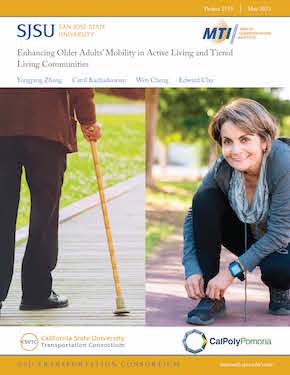- 408-924-7560
- mineta-institute@sjsu.edu
- Donate
Enhancing Older Adults’ Mobility in Active Living and Tiered Living Communities
The U.S. population is aging rapidly. As people get older, they increasingly face issues such as increased susceptibility to injuries and the need to be assisted with many day-to-day activities. Older adults have the opportunity to opt-in to live in an older adult community (OAC) based on their needs and capabilities. This study comprehensively reviews existing governing development regulations and design criteria related to the older adults’ communities, conducts surveys among people involved with some of these communities in California, and recommends improvements to community design for active living and tiered living communities. This study proposes a new scoring system to evaluate the overall life-space mobility of OACs and the surrounding areas. For each of the ten communities within California, the area's Active Mobility Infrastructure (AMI), both inside and outside, and Permeability (PERM) are assessed. Furthermore, the study aims to comprehend how residents feel about the available facilities and how they are utilized through a survey that includes questions regarding how frequently residents partake in active transportation within and outside their communities and assesses residents’ financial and educational standings. Using Welch’s T-Test, Pearson’s Correlation Coefficient, and a Multinomial Logit Regression model, this study addresses three questions: (1) Are there any statistically significant differences in the transportation connection qualities within and surrounding the older adult communities perceived by their residents? (2) Are there strong correlations between the quality of transport connections and the walking frequency of the residents? (3) What are the main influential factors of walking frequency? The findings from this research can aid transportation professionals in improving the governing development regulations and associated design criteria for better person-environment fit in older living communities.
YONGPING ZHANG, PHD, PE
Dr. Zhang is an Associate Professor from the Civil Engineering Department at California State Polytechnic University, Pomona (Cal Poly Pomona). His specialty areas include transportation planning, modeling, and policy development.
CAROL KACHADOORIAN
Ms. Kachadoorian is the Executive Director of dblTilde CORE, Inc., a nonprofit that promotes and researches active mobility and wellness for older adults. Her experience includes transit and transportation planning, operations, and community engagement.
WEN CHENG, PHD, PE, TE, PTOE
Dr. Cheng is a professor from the Civil Engineering Department at Cal Poly Pomona. His specialty areas include statistical modeling and traffic safety.
EDWARD CLAY
Mr. Clay is a Research Assistant from the Civil Engineering Department at Cal Poly Pomona. His specialty areas include statistical modeling, data mining, and computer vision.
-
Contact Us
San José State University One Washington Square, San Jose, CA 95192 Phone: 408-924-7560 Email: mineta-institute@sjsu.edu






